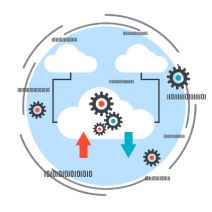Directive Blogs
Smart organizations are always looking for ways to improve how they do business. Digital transformation is a way for businesses to get the most out of their technology by improving workflows and overall efficiency. What does digital transformation look like and how can you implement it in your business?
By now, business owners are well aware of the many ways cloud computing can benefit their organization, such as providing increased mobility and flexibility. Despite the tantalizing list of benefits the cloud presents, some business owners may still be hesitant to switch to the cloud due to one major factor: the perceived lack of cost savings. Well, thanks to a recent study by John Burke, analyst and CIO of Nemertes Research, there’s new evidence showing how hosting workloads in the cloud is more cost-effective than the alternative, hosting operations on-premise.
By now you’ve heard about the cloud and all that it can do for businesses, but not all cloud providers can claim equal levels of availability and overall quality as others. Therefore, one of the most critical considerations you have to make when rolling out a cloud service regards who will be managing your company’s cloud computing platform.
Cloud computing offers businesses an economical way to obtain the software and services they need. Yet, there comes a point when having too much of a good thing becomes wasteful, no matter how affordable the service may be. If a business owner isn’t careful about how they utilize the cloud, then they can unknowingly find themselves experiencing “cloud waste.”
As a business owner, you’ve surely thought about what the future holds for your organization. However, one of the things that you need to think about that’s not often considered is the event of a data disaster. How can your business bounce back from such a catastrophic event? One of the first steps is understanding your data backup and disaster recovery process, as well as how you can improve your current setup.
When you hear us speak the world “cloud,” it’s not the fluffy white forms soaring overhead. The cloud that we refer to are computing systems that are delivered to you through an Internet connection. The popularity and demand for cloud services has led both ordinary consumers and businesses alike to seek them out. Despite this demand, in the United States alone, there are over 500,000 IT jobs available. This suggests that there may be a shortage of workers with the requisite skillset and can provide a unique incentive to join the industry as to take advantage of such massive growth.
Are you still hesitant to adopt cloud computing for your company’s IT needs? For the cautious business owner, adopting new technologies isn’t a move that’s to be made lightly. However, cloud computing is much more than a passing fad. In recent years, the cloud has become such a reliable and efficient tool for businesses that it deserves your attention. Take for example these three misconceptions about the cloud.
When it comes to using technology to improve your business, it’s hard to beat the benefits that cloud computing provides. The cloud can help to boost your functionality in a variety of ways. As a result, cloud technologies have seen explosive adoption rates--and it’s no wonder, when you consider what the cloud is capable of, and how it can benefit your workforce.
Businesses have focused on efficient utility software deployment for the better part of 30 years. Today, developers are increasingly offering software titles “as-a-service”, which gives users access to these powerful tools, via the cloud, for a consistent monthly payment. Distributing solutions through cloud technologies, be they a private cloud server or a reputable public cloud provider’s platform, can give your business considerable benefits.
Did you know that 43 percent of IT decision makers have plans to increase their cloud investments throughout 2017? This is according to a recent survey which, when combined with the steady rate of cloud adoption seen during the past decade, proves that the cloud is the next phase in the evolutionary development of business computing. While this shows great promise for the future, cloud adoption is not something to dive into blindly.
With Google Chrome’s Incognito mode, you can privately browse the web, but you may have noticed that Incognito mode also disables your extensions by default. This isn’t a big deal, but it can be an annoyance that you’d prefer not to deal with. Thankfully, there’s a good way to make sure that specific extensions stay enabled, even in Incognito mode.
Many businesses are searching for ways to go green. Most of the ones that do are trying to cut out their reliance on paper and printing. This is strategic thinking, of course, since the cost of printer toner has skyrocketed over the years. Today the most affordable printer ink on the market still comes in at an astounding $13 per ounce; or, slightly more than Dom Perignon. This is why businesses that are looking to cut costs, as well as embrace environmentally-friendly initiatives, are going paperless.
Updating your company’s software is a big responsibility that shouldn’t be overlooked. When it comes down to it, applying security patches and updates are some of the best preventative measures you can take to ensure the safety of your company’s data. Do you have a plan in place to handle all of your technology updates, or are you going about it haphazardly?
The cloud has seen explosive use of its services and solutions since it was first introduced, and for good reason--it offers benefits that are too useful for a business to pass up. These benefits vary, but all serve a singular purpose: to make the user’s experience easier. Here are some of the ways that the cloud can enhance the daily operations of your business.
Every business owner is painfully aware of how much their mission-critical software costs them. Yet, one metric that eludes many managers and CIOs alike is just how much value they’re getting from their software. Thanks to the cloud, assigning value to software and making decisions about enterprise technology accordingly, is easier than ever before!
For business owners looking to streamline operations and get the most out of their technology, a new survey by TSO Logic analyzed 10,000 customer physical servers and 25,000 virtual machines and concluded that 45 percent of existing VMs would run more efficiently in the cloud. A finding like this should be reason enough for companies to reevaluate their current IT setup.
The cloud lets your business share files easily and efficiently, but regardless of how useful this feature is, you need to make sure that your team understands how and why they’re given access to certain files. Giving the freedom to share files is great, but it can quickly become a hindrance when you have inexperienced users doing the sharing. Be sure to take these three risks into account before handing over the keys to your business’s file sharing.
The cloud makes operations more efficient and can save you plenty of capital in the long run, which is why many organizations are turning to it to further improve the way they do business. Yet, businesses that haven’t moved to the cloud will face steep competition from those that have. If you’re still not sure whether the cloud is right for your business, consider the following advantages of cloud computing for SMBs.
The best laid plans of mice and men often go awry, and there is no exception when it comes to your business technology. No matter how well-thought-out your systems are, you are always at a risk of some unforeseen threat causing havoc. In order to truly be prepared for anything, you need to implement a backup and disaster recovery solution for your business.
When it comes to cloud computing, the small business has plenty of choices. There are several different types of clouds, but depending on your business’s specific needs, you can narrow it down to three: the public, private, and hybrid varieties. Many businesses are finding that the public cloud is a more valuable asset than a private or hybrid cloud. We’ll dig into the details and explain to you what these benefits could mean for your business.
If your business is still on the fence about implementing a cloud solution, we don’t blame you. Moving to the cloud can be a daunting task, and you don’t want to jump the gun and make such a big decision on a whim. It’s important to understand why businesses move their data to the cloud in the first place, as well as what the different types of cloud solutions are and what they can offer your unique business model.
If your business is still on the fence about the cloud, you should make up your mind soon. The cloud is an investment that can help your business improve operations, cut costs, and boost productivity. It’s inevitable that most businesses will use the cloud, so it’s not a question of if, but when. Why not take this opportunity to get a head start on your competition with a cloud computing solution?
Hardware refreshes are often a time of great turmoil for businesses, particularly because of the cost of new servers and the time it takes to migrate data from one location to another. Thankfully, with the advent of virtualized servers, businesses have a viable alternative to the outright purchase of expensive, new hardware solutions. Instead, a virtual server that’s hosted in the cloud offers not only a more immediate reprieve, but can also significantly reduce costs for your organization in the long run.
Moving to the cloud is not an easy task, and it’s certainly not a process that will be the same for every SMB. Therefore, you need to be open to adaptation as the process wears on. Unplanned-for issues might make it difficult to adhere 100 percent to your plans, so if you can’t adapt to that which you can’t predict, your cloud migration is doomed to failure.
So, you’re convinced that cloud computing is the new way to go for your company. That’s great, and it’s an easy choice to make, seeing as the cloud affords organizations benefits such as increased productivity, improved collaboration, anytime/anywhere access, and much more. Now that you’ve decided to go with the cloud, what’s your next move as far as making this a reality?
Hosting an in-house IT infrastructure may give you the reassurance that all of your servers and network equipment are being cared for properly, but it’s important to realize that your time is better spent elsewhere, like running your business. If you’re unsure if you’re providing the necessary maintenance and management for your mission-critical hardware solutions, virtualization can present a valuable opportunity.
Every business owner needs to understand the pivotal role that technology plays in their business’s growth. However, many companies just aren’t able to keep up with the latest trends and developments. When this happens, they miss out on important opportunities to grow, and when an organization falls behind the times, they fall out of practice. When they fall out of practice… well, you get the idea.
Mobility is proving to be a major pain point for businesses, especially when it comes to implementing new technology solutions. It’s become crucial to consider how mobility can influence the growth of your business and improve operations, particularly with the cloud gaining ground and mobile devices becoming omnipresent in the workplace. How will your business learn from this influx of mobility?
Cloud computing may be a great asset to your business, but there are still plenty of executives that remain quite reluctant about implementing it. One of the big reasons is that security breaches are often covered with high exposure on the news, and this makes it seem like the cloud isn’t a good way to store sensitive data. Now, however, cloud computing security has reached a high point, and you can bet that the cloud has ways of enhancing IT security for your business, too.
The cloud is a great technology that’s changing the face of the business environment, but like every new innovation, there will always be those who are opposed to the cloud, and they can put your business in a precarious situation. Here are three ways that you can convince your team that cloud computing is the way to go, and that it’s a great way to take advantage of modern technology solutions.
There’s no denying that your business’s productivity suite is one of its most valuable software solutions. Cloud services like Google Apps for Work and Microsoft Office 365 continue to be huge game-changers in the business environment, and it’s been found that their increasing popularity is thanks to the convenience of providing mobile access to important data and applications.
 A short time ago, cloud computing was a resource that was only taken advantage of by organizations that could afford to virtualize and manage their hosted platforms. Nowadays, many businesses, including startups, are using cloud computing for their organization’s primary computing functions. As this enormous shift happened, many of the world’s largest companies have pushed their cloud platforms forward to offer secure storage, software deployment, and even communications for organizations that are either just starting out, or are looking to reduce their capital computing and support costs.
A short time ago, cloud computing was a resource that was only taken advantage of by organizations that could afford to virtualize and manage their hosted platforms. Nowadays, many businesses, including startups, are using cloud computing for their organization’s primary computing functions. As this enormous shift happened, many of the world’s largest companies have pushed their cloud platforms forward to offer secure storage, software deployment, and even communications for organizations that are either just starting out, or are looking to reduce their capital computing and support costs.
 There comes a time when your business needs to upgrade its technology. Holding out for as long as possible might seem beneficial for your wallet, but in the end, it’s much more cost-effective to replace outdated and inefficient technology before it winds up becoming a liability. In many cases, businesses might not even realize how much their outdated technology is hurting their bottom line. How can you know with certainty that it’s time to upgrade your technology?
There comes a time when your business needs to upgrade its technology. Holding out for as long as possible might seem beneficial for your wallet, but in the end, it’s much more cost-effective to replace outdated and inefficient technology before it winds up becoming a liability. In many cases, businesses might not even realize how much their outdated technology is hurting their bottom line. How can you know with certainty that it’s time to upgrade your technology?
 Businesses have a lot of data that they need to access on a daily basis. However, where this data is stored can have a dramatic effect on your organization’s productivity. Whether it’s stored in the cloud, locally on your in-house server, or in a safe and secure data center, you need to know where your data is stored, and what purpose it holds for your business.
Businesses have a lot of data that they need to access on a daily basis. However, where this data is stored can have a dramatic effect on your organization’s productivity. Whether it’s stored in the cloud, locally on your in-house server, or in a safe and secure data center, you need to know where your data is stored, and what purpose it holds for your business.
 The cloud is a technology that’s taking the business world by storm. Most organizations take advantage of some form of the cloud or another, be it for data storage, email hosting, or application deployment. Either way, it’s clear that the cloud is a technology that your business should be investing in, especially if you want to stay current in an increasingly competitive environment.
The cloud is a technology that’s taking the business world by storm. Most organizations take advantage of some form of the cloud or another, be it for data storage, email hosting, or application deployment. Either way, it’s clear that the cloud is a technology that your business should be investing in, especially if you want to stay current in an increasingly competitive environment.
 The cloud might be a great new data storage resource for SMBs to get more done during the workday, but it’s far more than that. Uses for the cloud are constantly evolving to adapt to a shifting online environment, and it’s now an indispensable tool for the serious modern business. The cloud is changing the way businesses handle their data and information, but it can do so much more.
The cloud might be a great new data storage resource for SMBs to get more done during the workday, but it’s far more than that. Uses for the cloud are constantly evolving to adapt to a shifting online environment, and it’s now an indispensable tool for the serious modern business. The cloud is changing the way businesses handle their data and information, but it can do so much more.
 Cloud services are growing more common to the world of small and medium-sized businesses, to the point where almost all businesses take advantage of the cloud in some way, shape, or form. However, a business’s specific cloud needs vary, and the same solution doesn’t work for everyone. Still, there are a few notable qualities that most SMBs want for their cloud in 2016.
Cloud services are growing more common to the world of small and medium-sized businesses, to the point where almost all businesses take advantage of the cloud in some way, shape, or form. However, a business’s specific cloud needs vary, and the same solution doesn’t work for everyone. Still, there are a few notable qualities that most SMBs want for their cloud in 2016.
 When one thinks about The Internet of Things, new and fantastic devices come to mind, like smart homes, smart cars, mobile devices, and more. While innovations like these are fueling the excitement behind the IoT, it’s actually the smaller, behind-the-scenes IoT devices which are poised to bring about the most significant change to our connected society.
When one thinks about The Internet of Things, new and fantastic devices come to mind, like smart homes, smart cars, mobile devices, and more. While innovations like these are fueling the excitement behind the IoT, it’s actually the smaller, behind-the-scenes IoT devices which are poised to bring about the most significant change to our connected society.
 Security is a huge problem for businesses that take advantage of the cloud, but never to the same degree. It’s often the nature of the industry which dictates how much a business should invest in cloud security. However, despite these differences in policy, there are some aspects of cloud security that absolutely can’t be overlooked, including data permissions, account security, vulnerability to malware, and other online issues.
Security is a huge problem for businesses that take advantage of the cloud, but never to the same degree. It’s often the nature of the industry which dictates how much a business should invest in cloud security. However, despite these differences in policy, there are some aspects of cloud security that absolutely can’t be overlooked, including data permissions, account security, vulnerability to malware, and other online issues.
 There was a time when the cloud was considered nothing more than a novelty, but now that most serious businesses are taking full advantage of cloud computing, it’s time that you consider it a viable option for your organization. For those who are unfamiliar with cloud computing, though, you want to make sure that you properly plan out the process of moving to the cloud. When it comes to remodeling your IT infrastructure around the cloud, doing so can save you a lot of pain.
There was a time when the cloud was considered nothing more than a novelty, but now that most serious businesses are taking full advantage of cloud computing, it’s time that you consider it a viable option for your organization. For those who are unfamiliar with cloud computing, though, you want to make sure that you properly plan out the process of moving to the cloud. When it comes to remodeling your IT infrastructure around the cloud, doing so can save you a lot of pain.
 The cloud is a fantastic addition to the business environment that can aid your organization in achieving great things with your technology, but some professionals still feel that the cloud isn’t as secure as it needs to be, especially in light of the incredible number of threats loose on the Internet. However, contrary to popular belief, the cloud is a very effective way of storing data, particularly for your business’s data backups.
The cloud is a fantastic addition to the business environment that can aid your organization in achieving great things with your technology, but some professionals still feel that the cloud isn’t as secure as it needs to be, especially in light of the incredible number of threats loose on the Internet. However, contrary to popular belief, the cloud is a very effective way of storing data, particularly for your business’s data backups.
 Cloud computing is a normal part of today’s business landscape. In fact, in a recent poll of IT and business executives by Harvard Business Review and Verizon, 84 percent of respondents said they increased their use of cloud services in the past year-- 39 percent of which “increased significantly.” However, with more users accessing cloud data, business owners must be mindful of employee permissions.
Cloud computing is a normal part of today’s business landscape. In fact, in a recent poll of IT and business executives by Harvard Business Review and Verizon, 84 percent of respondents said they increased their use of cloud services in the past year-- 39 percent of which “increased significantly.” However, with more users accessing cloud data, business owners must be mindful of employee permissions.
 Your business’s desktop infrastructure is an imperative part of operations, but thanks to the latest virtualization technology, there are easier ways to manage multiple desktops. For example, you can take advantage of an in-house virtual desktop infrastructure, or implement a dynamic outsourced Desktop as a Service (DaaS) offering. Let’s take a look at the differences between the two.
Your business’s desktop infrastructure is an imperative part of operations, but thanks to the latest virtualization technology, there are easier ways to manage multiple desktops. For example, you can take advantage of an in-house virtual desktop infrastructure, or implement a dynamic outsourced Desktop as a Service (DaaS) offering. Let’s take a look at the differences between the two.
 Cloud computing grows more popular by the day, and it continues to show its value to a modern business world. Being able to dynamically access content while online is a great asset, but of course, this doesn’t come without taking some risks and gambling your data’s security. Thankfully, there are some ways in which you can tip the odds in your favor.
Cloud computing grows more popular by the day, and it continues to show its value to a modern business world. Being able to dynamically access content while online is a great asset, but of course, this doesn’t come without taking some risks and gambling your data’s security. Thankfully, there are some ways in which you can tip the odds in your favor.
 Technology has the potential to make the future of your business a success. Although, if you don’t manage your company’s technology properly, it can hinder your business, causing you to miss out on future success. In order to take full advantage of what technology can do for you, you’ll have to keep the future in mind.
Technology has the potential to make the future of your business a success. Although, if you don’t manage your company’s technology properly, it can hinder your business, causing you to miss out on future success. In order to take full advantage of what technology can do for you, you’ll have to keep the future in mind.
 Technology changes constantly, and as such it can be difficult to change and adapt to new trends in the industry. Cloud services are making the implementation of scalable solutions somewhat easier, but often times integrating cloud solutions is forgotten by business owners who don’t really know what the cloud can offer their organization.
Technology changes constantly, and as such it can be difficult to change and adapt to new trends in the industry. Cloud services are making the implementation of scalable solutions somewhat easier, but often times integrating cloud solutions is forgotten by business owners who don’t really know what the cloud can offer their organization.
 It’s been proven that the cloud is ideal for improving the way that organizations just like yours are handling their day-to-day operations, bringing both an increase in profits, net growth, and staff productivity. So, naturally, small businesses are moving in the direction of taking advantage of the cloud for their computing needs.
It’s been proven that the cloud is ideal for improving the way that organizations just like yours are handling their day-to-day operations, bringing both an increase in profits, net growth, and staff productivity. So, naturally, small businesses are moving in the direction of taking advantage of the cloud for their computing needs.
 Staying on top of your company’s budget is a key component to increasing your revenue. By failing to do so, major expenses will blindside you and cancel out any progress that might have otherwise been made from increased sales. For many companies, one of the worst budget busters comes from their IT.
Staying on top of your company’s budget is a key component to increasing your revenue. By failing to do so, major expenses will blindside you and cancel out any progress that might have otherwise been made from increased sales. For many companies, one of the worst budget busters comes from their IT.
 With so many businesses switching to the cloud for their data storage needs, it’s assumed that their data will be safe and sound. However, this is only somewhat true. While it’s true that the cloud is a secure and effective way to store your data, the virtual cloud is still vulnerable to freak accidents. Take, for example, the time when Google was struck by lightning last month… four times.
With so many businesses switching to the cloud for their data storage needs, it’s assumed that their data will be safe and sound. However, this is only somewhat true. While it’s true that the cloud is a secure and effective way to store your data, the virtual cloud is still vulnerable to freak accidents. Take, for example, the time when Google was struck by lightning last month… four times.
 Cloud computing is already heavily utilized in the business world. Companies that were looking to add mobility, collaborative capacities, and overall flexibility, have rolled out cloud computing platforms for their business and it’s resulted in quite a few benefits. In fact, according to a 2014 survey, about 70 percent of enterprise-level companies have instituted some sort of IaaS, PaaS, or SaaS solution. As more companies implement cloud solutions for critical business functions, owners of smaller businesses are asking us the inevitable question, “Is the cloud right for my business?”
Cloud computing is already heavily utilized in the business world. Companies that were looking to add mobility, collaborative capacities, and overall flexibility, have rolled out cloud computing platforms for their business and it’s resulted in quite a few benefits. In fact, according to a 2014 survey, about 70 percent of enterprise-level companies have instituted some sort of IaaS, PaaS, or SaaS solution. As more companies implement cloud solutions for critical business functions, owners of smaller businesses are asking us the inevitable question, “Is the cloud right for my business?”
 By now you’ve heard of managed services: Technology-related services that allow businesses to get the IT support they need without taking on the often large and unexpected expenses that usually accompany them. This allows a business the ability to budget a flat fee for their technology support each month, and address IT support needs that include communication, application deployment, and the proactive support of the business’ IT infrastructure. The overall managed services industry has seen immense growth as businesses look to cut their support costs, while continuing to build onto their IT infrastructure.
By now you’ve heard of managed services: Technology-related services that allow businesses to get the IT support they need without taking on the often large and unexpected expenses that usually accompany them. This allows a business the ability to budget a flat fee for their technology support each month, and address IT support needs that include communication, application deployment, and the proactive support of the business’ IT infrastructure. The overall managed services industry has seen immense growth as businesses look to cut their support costs, while continuing to build onto their IT infrastructure.
 How much thought have you put into your business’s cloud solution? If you haven’t already considered cloud computing, you definitely should. There’s a reason why cloud spending is in third place overall in IT expenditures, and that’s thanks to the overwhelming benefits that it offers in contrast to the traditional IT network model.
How much thought have you put into your business’s cloud solution? If you haven’t already considered cloud computing, you definitely should. There’s a reason why cloud spending is in third place overall in IT expenditures, and that’s thanks to the overwhelming benefits that it offers in contrast to the traditional IT network model.
 When it comes to your business' backup, you have a ton of options, but how much thought have you honestly put into it? It’s naturally one of the most imperative parts of your entire IT infrastructure, so you want to pay particularly close attention to how you are storing and receiving your data in the event of a disaster.
When it comes to your business' backup, you have a ton of options, but how much thought have you honestly put into it? It’s naturally one of the most imperative parts of your entire IT infrastructure, so you want to pay particularly close attention to how you are storing and receiving your data in the event of a disaster.
 Do you know the difference between virtualization and cloud computing? If you don’t, it’s not a reason to be embarrassed. Most business owners have a hard time distinguishing the two and find the topic to be rather technical. Yet, we think businesses can benefit greatly from knowing the differences so they’ll end up with the right solution.
Do you know the difference between virtualization and cloud computing? If you don’t, it’s not a reason to be embarrassed. Most business owners have a hard time distinguishing the two and find the topic to be rather technical. Yet, we think businesses can benefit greatly from knowing the differences so they’ll end up with the right solution.
 When you think of the Internet of Things, does your mind immediately wander into the realm of connected devices that change the way we interact with each other? Or, does it consider the security issues that can potentially become a threat to your entire network and technology infrastructure? Hopefully it’s a little of both, with an emphasis placed on security.
When you think of the Internet of Things, does your mind immediately wander into the realm of connected devices that change the way we interact with each other? Or, does it consider the security issues that can potentially become a threat to your entire network and technology infrastructure? Hopefully it’s a little of both, with an emphasis placed on security.
 Despite the clear advantages that cloud computing offers to modern businesses, some organizations are hesitant to incorporate it into their IT infrastructure. Due to the cloud’s fairly recent insurgence, it’s natural to feel some sort of anxiety toward cloud integration. However, these fears aren’t necessarily warranted, and some can directly influence your ability to grow and expand.
Despite the clear advantages that cloud computing offers to modern businesses, some organizations are hesitant to incorporate it into their IT infrastructure. Due to the cloud’s fairly recent insurgence, it’s natural to feel some sort of anxiety toward cloud integration. However, these fears aren’t necessarily warranted, and some can directly influence your ability to grow and expand.
 A few short years ago, it seemed like one of our primary missions was to educate the public on the benefits of cloud computing. Now, almost everyone uses the cloud (whether they fully understand it or not), and, they’ve developed expectations on what the cloud should do. If a cloud service isn’t meeting these expectations, then consumers will find another one that does.
A few short years ago, it seemed like one of our primary missions was to educate the public on the benefits of cloud computing. Now, almost everyone uses the cloud (whether they fully understand it or not), and, they’ve developed expectations on what the cloud should do. If a cloud service isn’t meeting these expectations, then consumers will find another one that does.
 Most companies are moving to the cloud in hopes of revolutionizing the way they maintain their mission-critical data and applications. Despite this fact, there are some businesses that don’t know the first thing about cloud computing, or even the different kinds of cloud offerings that can be chosen from.
Most companies are moving to the cloud in hopes of revolutionizing the way they maintain their mission-critical data and applications. Despite this fact, there are some businesses that don’t know the first thing about cloud computing, or even the different kinds of cloud offerings that can be chosen from.
 Most IT administrators see virtualization as a means of increasing efficiency, and they’re not wrong. Virtualization of your hardware is a great way of decreasing operating costs and improving accessibility to mission-critical applications and information. However, network virtualization has the potential to increase the security of your business’s data, too.
Most IT administrators see virtualization as a means of increasing efficiency, and they’re not wrong. Virtualization of your hardware is a great way of decreasing operating costs and improving accessibility to mission-critical applications and information. However, network virtualization has the potential to increase the security of your business’s data, too.
 Cloud computing has taken the business world by storm, but despite this, some entrepreneurs aren’t so convinced that migrating their data to the cloud is a good idea. These business owners usually make this decision based off of misconceptions surrounding the cloud, which might be preventing them from making full use of it. Here are two of the most common misconceptions surrounding the cloud.
Cloud computing has taken the business world by storm, but despite this, some entrepreneurs aren’t so convinced that migrating their data to the cloud is a good idea. These business owners usually make this decision based off of misconceptions surrounding the cloud, which might be preventing them from making full use of it. Here are two of the most common misconceptions surrounding the cloud.
 From the perspective of a business owner, spending money on technology is an investment that one hopes to see a return on (ROI). After the initial investment is returned, then all funds generated by the technology are sweet profit--which is the driving goal for every business. One technology that’s the most capable of driving profits for business is cloud computing.
From the perspective of a business owner, spending money on technology is an investment that one hopes to see a return on (ROI). After the initial investment is returned, then all funds generated by the technology are sweet profit--which is the driving goal for every business. One technology that’s the most capable of driving profits for business is cloud computing.
 When a dining establishment goes out of business, it usually doesn’t make the news. After all, running a restaurant is a risky endeavor. However, for one Washington D.C. eatery, it’s blaming its failure a Google Places mishap, which makes you think twice about how important it is for your business to have its online information properly displayed.
When a dining establishment goes out of business, it usually doesn’t make the news. After all, running a restaurant is a risky endeavor. However, for one Washington D.C. eatery, it’s blaming its failure a Google Places mishap, which makes you think twice about how important it is for your business to have its online information properly displayed.
 The world of online currency is a strange, bizarre realm. While it’s designed for online transactions, it has gone from the somewhat useful (Bitcoin) to just plain silly (Dogecoin). However, there’s now an anonymous cryptocurrency available for use called Darkcoin, which attempts to make online transactions more difficult to trace.
The world of online currency is a strange, bizarre realm. While it’s designed for online transactions, it has gone from the somewhat useful (Bitcoin) to just plain silly (Dogecoin). However, there’s now an anonymous cryptocurrency available for use called Darkcoin, which attempts to make online transactions more difficult to trace.
 The Internet of Things is changing the face of web-connected devices as we know it. Some would argue that the world isn’t ready for the IoT, but it’s on its way nonetheless. But what really constitutes the Internet of Things? InfoWorld suggests that a lot of what the public sees as the Internet of Things shouldn’t be classified as IoT devices. Therefore, we need a more substantial definition for this revolutionary phenomenon.
The Internet of Things is changing the face of web-connected devices as we know it. Some would argue that the world isn’t ready for the IoT, but it’s on its way nonetheless. But what really constitutes the Internet of Things? InfoWorld suggests that a lot of what the public sees as the Internet of Things shouldn’t be classified as IoT devices. Therefore, we need a more substantial definition for this revolutionary phenomenon.
 With the Internet of Things connecting more devices to the Internet, these devices can potentially be turned to nefarious use. Despite all of the benefits of the Internet of Things, like big data analytics, anything connected to the Internet is threatened by cyber crime to at least some degree. In fact, some professionals believe that the Internet of Things will usher in an era of new types of cyber crime; murder included.
With the Internet of Things connecting more devices to the Internet, these devices can potentially be turned to nefarious use. Despite all of the benefits of the Internet of Things, like big data analytics, anything connected to the Internet is threatened by cyber crime to at least some degree. In fact, some professionals believe that the Internet of Things will usher in an era of new types of cyber crime; murder included.
 Virtualization is all the rage in the technology world. In fact, virtual servers are practically omnipresent in modern workplaces. Why? Because they offer businesses unprecedented opportunity for growth and development. The benefits of virtualized servers far outweigh the costs, aiding businesses in expanding their goals and visions for the future.
Virtualization is all the rage in the technology world. In fact, virtual servers are practically omnipresent in modern workplaces. Why? Because they offer businesses unprecedented opportunity for growth and development. The benefits of virtualized servers far outweigh the costs, aiding businesses in expanding their goals and visions for the future.
 For the modern-day business owner, moving to the cloud means to take advantage of the several strategic advantages it offers. Companies no longer have to restrict themselves by relying on physical servers, desktops, or hardware. Most businesses see the value that cloud-based operations can offer them, and they are racing to take advantage of this fairly recent development. In fact, Joe McKendrick of Forbes magazine says that four-out-of-five small businesses will be based in the cloud in the near future.
For the modern-day business owner, moving to the cloud means to take advantage of the several strategic advantages it offers. Companies no longer have to restrict themselves by relying on physical servers, desktops, or hardware. Most businesses see the value that cloud-based operations can offer them, and they are racing to take advantage of this fairly recent development. In fact, Joe McKendrick of Forbes magazine says that four-out-of-five small businesses will be based in the cloud in the near future.
 Most of the Internet's data is stored in data centers. Logistically, data centers are a great solution to store ridiculous amounts of data. However, from an environmental perspective, data centers may be doing more harm than good. This, according to a new report by the National Resources Defense Council.
Most of the Internet's data is stored in data centers. Logistically, data centers are a great solution to store ridiculous amounts of data. However, from an environmental perspective, data centers may be doing more harm than good. This, according to a new report by the National Resources Defense Council.
 How your business chooses to store its data is a major decision. You can implement a private cloud computing model and spend more on equipment and maintenance than you need to, or you can save money with a public cloud. Although, in light of the recent celebrity-nude-photo-iCloud hack, is the public cloud secure enough to host your company's data? Let's address this concern and explore your cloud computing options.
How your business chooses to store its data is a major decision. You can implement a private cloud computing model and spend more on equipment and maintenance than you need to, or you can save money with a public cloud. Although, in light of the recent celebrity-nude-photo-iCloud hack, is the public cloud secure enough to host your company's data? Let's address this concern and explore your cloud computing options.


